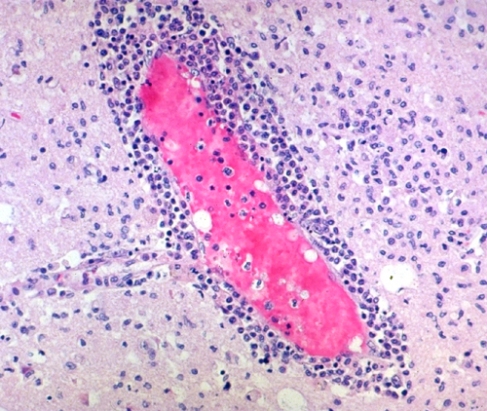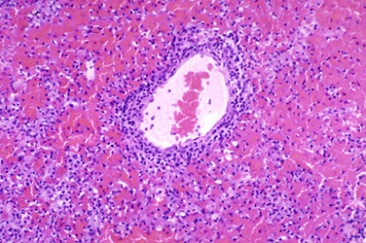Viral Encephalitis
The term Viral Encephalitis is often met at the medical centers like hospitals or municipal health offices wherein the patients suffered the said ailment that creates sadness among the family member of the patient
The viral encephalitis is an ailment caused by a virus. Encephalitis is an inflammation of the brain. Most often, it is caused by a viral infection or different viruses. The most common are the herpes viruses, childhood viruses such as measles, and viruses transmitted by a mosquito bite. There are two types of encephalitis — primary and secondary. In primary encephalitis, a virus attacks the brain and spinal cord directly. In secondary or post-infectious encephalitis, the virus invades another part of your body and travels to your brain. The virus causes inflammation of the nerve cells (encephalitis) or the surrounding membranes (meningitis). Encephalitis is different from meningitis, but these two brain infections often occur together. Encephalitis can be mild and don’t last long but however in some cases, it is life threatening and be fatal.
How does it starts? 90% of patients have flu-like symptoms like fever, sore throat, cough and malaise or uneasiness. Then if meningitis accompanies encephalitis, the patient may experience headache, stiff neck, uncomfortable with the presence of light and frequent vomiting. The patient with severe encephalitis usually have some change in consciousness, ranging from mild confusion to comatose that includes disorientation and delusions with possible hallucinations, shaking or stirring, emotional state of excitement or restlessness and even psychomotor agitation then some personality changes. Almost 50% of patients may have seizures. Some symptoms depend on which area of the brain is affected that may include trouble using or understanding words or coordinating voluntary muscle movements, muscle weakness r partial paralysis of the body, involuntary muscle movements and unstable body temperature. If an infant have encephalitis, they may have bulging in the fontanels or soft spots on the skull.
What are the possible causes? Arboviruses or viruses carried by insects are the common causes of viral encephalitis like that of a mosquito bites. Then other viruses includes the following:
The viruses that commonly cause viral encephalitis include:
- Herpes simplex virus type 1 (HSV-1), which is responsible for cold sores
- HSV-2, which is responsible for genital herpes
- Varicella zoster virus, which causes chicken pox and shingles
- Epstein-Barr virus, which causes mononucleosis
- Childhood viruses that can cause encephalitis include:
- Measles (rubeola)
- German measles (rubella)
- Mumps
Not all cases of encephalitis are caused by viruses. Some other causes of encephalitis include:
- Bacterial infection
- Fungal infection
- Parasitic infection
- Noninfectious causes, such as allergic reactions or toxins
No one is spared since it could attack anybody but listed to be possible risk factors include the following:
- Being very young or an older adult
- Being exposed to mosquitoes or ticks
- Having a weakened immune system
- Not being vaccinated against measles, mumps, and rubella
- Traveling to areas where viral encephalitis is common
Encephalitis is a serious condition, so you should see a doctor if you or anybody especially the child start having symptoms of encephalitis. Diagnosis and initial treatment usually happens in a hospital. After doing a physical exam, a doctor may take the following steps to diagnose the condition:
- Blood test — finds viruses in the blood
- Spinal tap (lumbar puncture) — finds viruses in the fluid that surrounds the brain and spinal cord
- Brain imaging — magnetic resonance imaging (MRI) and computerized tomography (CT) scan see whether swelling is present in the brain
- Electroencephalogram (EEG) — finds abnormal brain waves
The best way to prevent encephalitis is to avoid getting viruses that lead to encephalitis:
- Protect yourself from mosquitoes. Use insect repellent and wear long pants and long sleeves. The most effective bug sprays use DEET, picaridin, or oil of lemon eucalyptus. Do not apply insect repellent to children under 2 years of age.
- Make sure your child is vaccinated against childhood diseases such as the measles, mumps, and rubella (MMR).
- Eat a healthy diet to keep your immune system healthy.
Viral encephalitis is a serious medical condition. Although there are no specific medications to treat encephalitis, often people with symptoms are given the antiviral medication acyclovir (Zovirax). It works against herpes simplex and varicella-zoster viruses. Complementary and alternative therapies have not been studied very much for the treatment of encephalitis. But some studies indicate that scalp acupuncture, combined with proper medication, may help the healing process.
Treatment includes careful observation and supportive care, including rest, proper nutrition, and fluids, to allow the body to fight the infection. You should always see your doctor if you have symptoms of encephalitis; don’t try to treat yourself.
Always tell your health care provider about the herbs and supplements you are using or considering using, as some supplements may interfere with conventional treatments.
Medications used to treat viral encephalitis include:
- Acyclovir (Zovirax) — treats encephalitis caused by HSV, VZV, and EBV
- Ganciclovir (Cytovene) — treats encephalitis caused by cytomegalovirus and HSV1
- Anticonvulsant medications — prevent and treat seizures associated with encephalitis
No specific vitamins or supplements have been shown to reduce symptoms of encephalitis. However, following these tips may help your overall health as you recover:
- Eat antioxidant foods, including fruits (such as blueberries, cherries, and tomatoes), and vegetables (such as squash and bell peppers).
- Avoid refined foods, such as white breads, pastas, and especially sugar.
- Eat fewer red meats and more lean meats, cold-water fish, tofu (soy, if no allergy), or beans for protein.
- Use healthy oils in foods, such as olive oil or vegetable oil.
- Avoid caffeine, alcohol, and tobacco.
- Drink 6 – 8 glasses of filtered water daily.
These supplements may also help improve your overall health:
- Omega-3 fatty acids, such as fish oil, one to three times daily, to help decrease inflammation and help with immunity. Fish oil may increase the risk of bleeding, so ask your doctor before taking it.
- Vitamin C, 500 – 1,000 mg one to three times daily, as an antioxidant and for immune system support.
- Probiotic supplement (containing Lactobacillus acidophilus), 5 – 10 billion CFUs (colony forming units) a day, for digestive and immune system health. If you are taking antibiotics, taking probiotics as well may help you avoid some side effects such as diarrhea. You should refrigerate your probiotic supplements for best results.
Full recovery from encephalitis can take weeks or months. People recovering from serious cases may have complications ranging from fatigue and difficulty concentrating to tremors and personality changes.
The most severe problems associated with encephalitis come from the destruction of nerve cells in the brain. How severe the complications are depends on the person’s immune system — whether it is healthy or weak — and what infection caused the encephalitis. For example, many of those infected with Eastern equine encephalitis and St. Louis encephalitis have permanent brain damage, such as problems with memory, speech, vision, hearing, muscle control, and sensation, and a low survival rate. Those infected with Epstein-Barr or varicella zoster rarely have any serious complications.
Reaction & Moral lesson:
Upon reading the report about viral encephalitis, it had given me the chance to understand how complicated this ailment can be. What is more dangerous is the fact that it can be fatal. Thus I asked some people about the ailment aside from reading and the more that I begun to understand it. Thus it is indeed needed for us to be cautious at all time about possible viral infection. We should never neglect and disregard any ailment or discomfort we are feeling. It is not a crime to consult a doctor thus medical treatment to seek medical advisory or medical advice should always be a part of our routine to keep ourselves healthy and ailment free. Then cleanliness of the surroundings should be a part of our maintenance of our houses and avoid going t places with possible insect bites since we never know when we will be infected by such virus. Aside from cleanliness, I have been able to realize how essential it is to have a healthy lifestyle thru exercises that will enable us to be physically fit and then eating the right food, the nutritious one to keep our body strong and immune system powerful to be able to counteract possible ailments like viral encephalitis.
The medical terms and definitions are quite not a lay man’s term thus it is not easy to understand but to comprehend it , I must say that what is essential is to know that I try to keep myself in line with physical fitness and maintaining a healthy lifestyle who is not afraid to seek medical assistance when needed.
Our body is sacred but very vulnerable to diseases or any form of ailment that viral encephalitis is quite a danger to us since there are some stories or experiences wherein the patient undergo coma and never wakes up, some wakes up but unfortunately lasted just for days or weeks. Thus viral infections like the said ailment should not be treated as a joke nor something to neglect rather be considered as a serious medical issue that should be taken as a warning for everyone of us to counteract and do our own role to stay away from it.
Bibliography:
Barak V, Halperin T, Kalickman I. The effect of Sambucol, a black elderberry-based, natural product, on the production of human cytokines: I. Inflammatory cytokines. Eur Cytokine Netw. 2001;12(2):290-6.
Cabrera C, Artacho R, Gimenez R. Beneficial effects of green tea — a review. J Am Coll Nutr. 2006;25(2):79-99.
Fiore C, Eisenhut M, Krausse R, Ragazzi E, Pellati D, Armanini D, Bielenberg J. Antiviral effects of Glycyrrhiza species. Phytother Res. 2008 Feb;22(2):141-8. Review.
Fauci AS, Braunwald E, Isselbacher KJ, et al, eds. Harrison’s Principles of Internal Medicine. 17th ed. Vol 1. New York, NY: McGraw-Hill; 2008.
Gaby AR. The role of coenzyme Q10 in clinical medicine: Part 1. Alt Med Rev. 1996; 1(1):11-17.
Gorbach SL, Bartlett JG, Blacklow NR: Infectious Diseases. 3rd ed. Philadelphia, Pa: W.B. Saunders Company; 2003.
Katz TM, Miller JH, Hebert AA. Insect repellents: historical perspectives and new developments. J Am Acad Dermatol. 2008 May;58(5):865-71. Review.
Kimura K, Ozeki M, Juneja LR, Ohira H. l-Theanine reduces psychological and physiological stress responses. Biol Psychol. 2006 Aug 21.
LaValle JB, Krinsky DL, Hawkins EB, et al. Natural Therapeutics Pocket Guide. Hudson, OH: LexiComp; 2000: 452-454.
Patrick L. Nutrients and HIV: part three – N-acetylcysteine, alpha-lipoic acid, L-glutamine, and L-carnitine. Altern Med Rev. 2000;5(4):290-305.
Marx JA, Hockberger RS, eds. Emergency Medicine: Concepts and Clinical Management. 6th ed. St. Louis, Mo: Mosby-Year Book; 2006.
Rotsein OD. Oxidants and antioxidant therapy. Crit Care Clin. 2001;17(1):239-47.
Simopoulos AP. Omega-3 fatty acids in inflammation and autoimmune diseases. J Am Coll Nutr. 2002;21(6):495-505.
Wang HK. The therapeutic potential of flavonoids. Expert Opin Investig Drugs. 2000;9(9):2103-19.
Williams JE. Review of antiviral and immunomodulating properties of plants of the Peruvian rainforest with a particular emphasis on Una de Gato and Sangre de Grado. Altern Med Rev. 2001;6(6):567-79.
Yoon JH, Baek SJ. Molecular targets of dietary polyphenols with anti-inflammatory properties. Yonsei Med J. 2005;46(5):585-96

